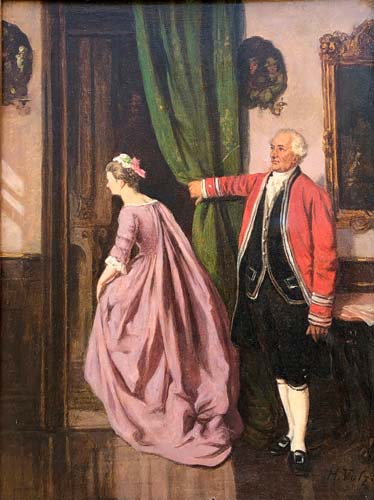
The Festival of Historic Houses of Friuli Venezia Giulia, organized by the Associazione Dimore Storiche Italiana – Sezione FVG (A.D.S.I. FVG), promotes the cultural, historical, artistic and landscape heritage of private historic houses, still inhabited by their owners, who open their homes, gardens and parks to visitors, acting as their guides to tell the evocative stories they are imbued with.
Access to guided visits
The guided tour of the house is offered to visitors who join by free donation to the fundraiser (minimum €10 per person, free for accompanied minors), which will be used to support ADSI FVG’s private cultural heritage tourism enhancement projects.
Hours
Visits and events will be conducted according to the times specified for each house.
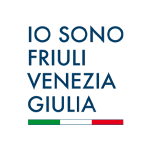

| Title | Category | Address |
|---|
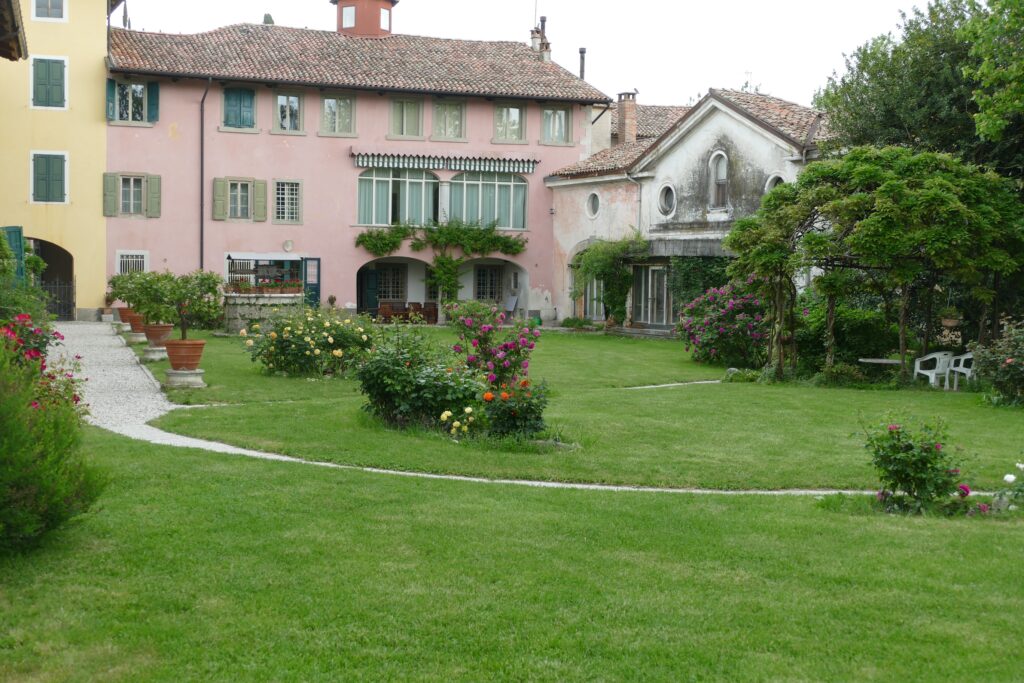
The mansion is the seat of an ancient Friulian family that still lives there. The oldest core dates back to the 16th century, but it was later enlarged and modified in the 18th, 19th and first half of the 20th century. Inside there are frescoed rooms, period furnishings, a chapel and a family archive with documents from the 13th to the 19th century.
In the 18th century, Count Fabio Asquini made it the centre of an important farm where, among other things, Picolit wine was produced, exported to courts all over Europe, and where peat was used as fuel for baking bricks and crockery. The garden open to visitors, at the end of which there is a 15th-century church, was created at the end of the 19th century according to the romantic taste then in vogue and was recently extended by the current owners.
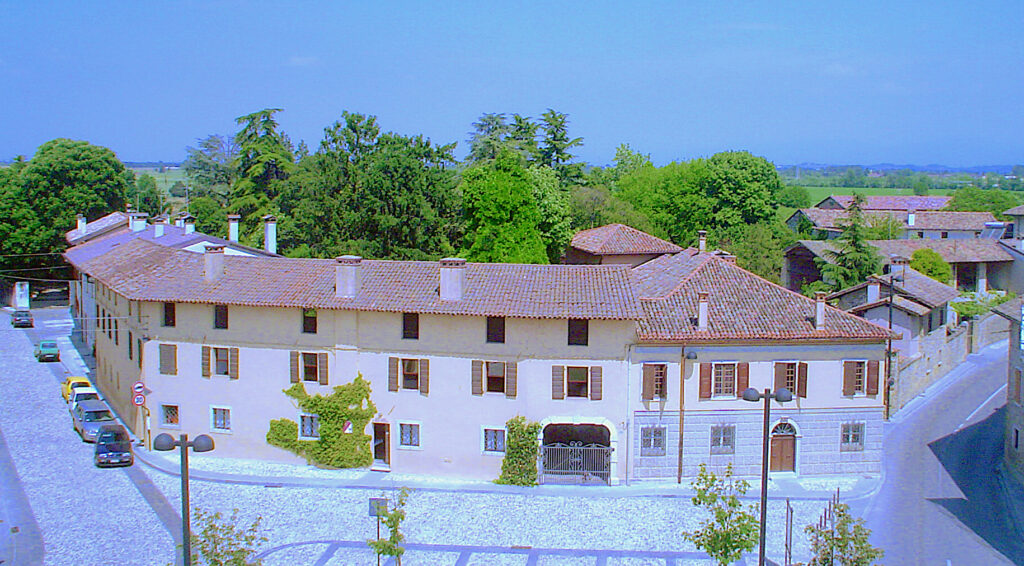
The Calligaris manor complex now Foffani is among the most prominent in the square of Clauiano, one of the most beautiful villages in Italy. The village is mainly made up of small buildings and houses from the eighteenth century or transformed in that period, an excellent example of traditional and rural Friulian architecture. The main house and the annexed buildings, which today are almost in the same configuration as an ancient map of 1774, have always been inhabited by the Calligaris family, as shown by documents dated 1608 and 1687.
Today, the only owner is Giovanni Foffani, son of Maria Calligaris.
The complex is an example of bourgeois country architecture, historically intended for the manor farm and in particular for the production of wine (officially documented since 1789) and for the breeding of silkworms.
In 1704, part of the courtyard was sold, and the “turret” was built, now used as a charming holiday home (Casa Antica Mosaici), with the old wooden stairs and stucco from the period on the first floor ceilings.
During the Second World War, the house was first the headquarters of the German command of the area and then of the American one.
The garden always amazes with its centuries-old wisteria, which has climbed up the nearby trees. Difficult to capture with a single image, it should be discovered little by little for its shapes and its scent between April/May, before the petals of its flowers fall and form a soft, purple carpet over the gravel for a few days.
Before visiting the cellar, a walk in the garden is pleasant, which is characterized, in addition to the wisteria, by a widespread presence of climbing plants on the walls, mainly ivy. In the largest part, towards the vineyard, you will find centuries-old trees, such as the Lebanese cedar, the magnolia and silver pines. They complete and close the spaces with privet, lime and hackberry trees, all around the large garden.
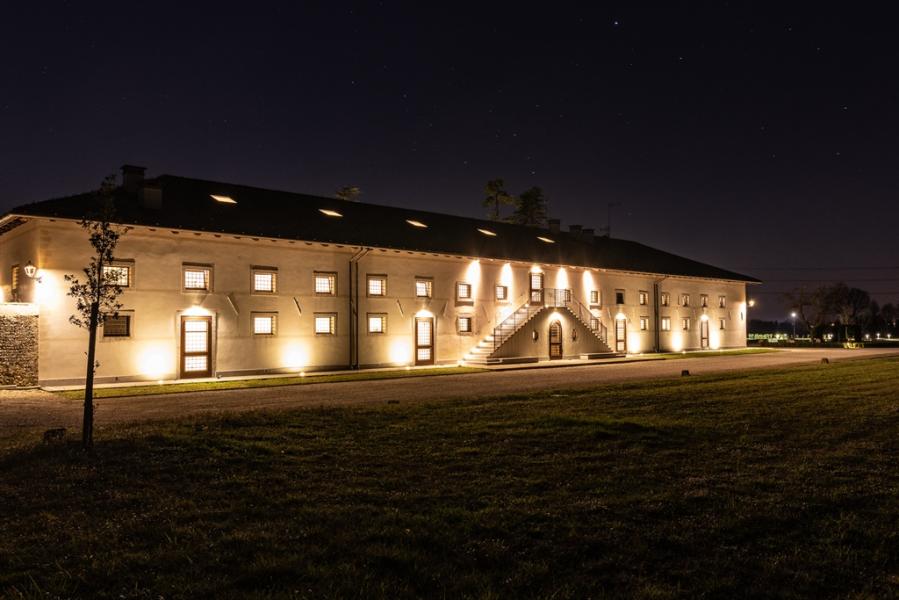
Villa Rubini in Merlana was built in the 18th century by the ancient Friulian family of Count Mantica.
In 1833 Count Nicolò del fu Leonardo Mantica sold the entire complex, with the adjacent agricultural estate of 272 Friulian fields, to Domenico Rubini who, developing his father Pietro’s business, had become one of the largest producers of silk yarn in Friuli, yarn which he provided for large-scale trading, traveling (evidently by carriage!) to Milan and Vienna, where he had set up warehouses of his products.
It was he who arranged for a new agricultural warehouse to be built on the north side of the garden, replacing the previous smaller one. This is the typical “folador” of the Friulian plain: that is, a building with on the ground floor two long side-by-side rooms, one on the south side intended as a vat cellar, and one on the north side intended as a wine cellar, and on the second floor a single room intended for grain storage.
At a later period, the building was used for silkworm breeding, installing the necessary stoves, which were later removed.
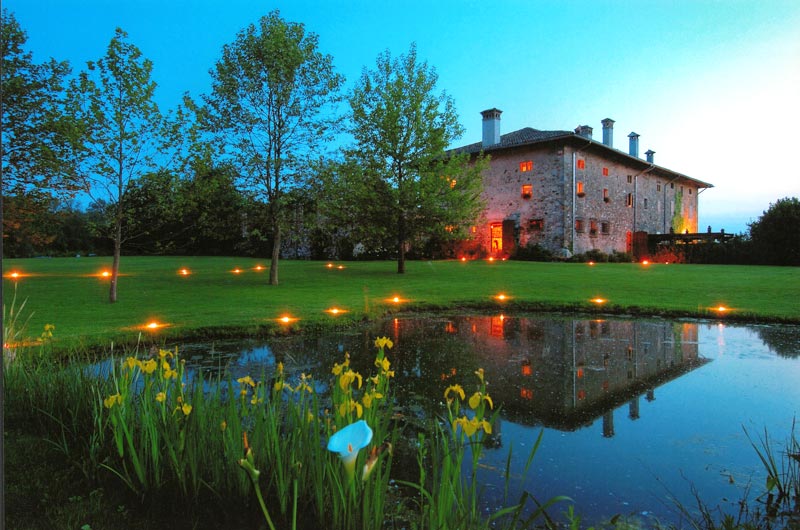
Brunelde is a Casaforte of thirteenth-century origin, built on pre-existing Roman structures, today in the guise of a sixteenth-century Villa. It preserves intact exposed beams, stone walls, frescoes, sixteenth-century floors and original furnishings, where you can relive a medieval atmosphere.
You can visit the family church, the park and the residence of the Counts of Arcano (who still reside there), with the ancient kitchen equipped with a working weight rotisserie, the dining room with the collection of pewter and halberds, the fireplace with the large fireplace and the red and white chessboard, the small living room with portraits of the ancestors, the study with the historical archive and the family tree and many strange and curious objects.
The visit continues in the part where once there were the canipa and the granary, today renovated into rooms, the Hall of Justice and suites, available to guests for parties and stays.
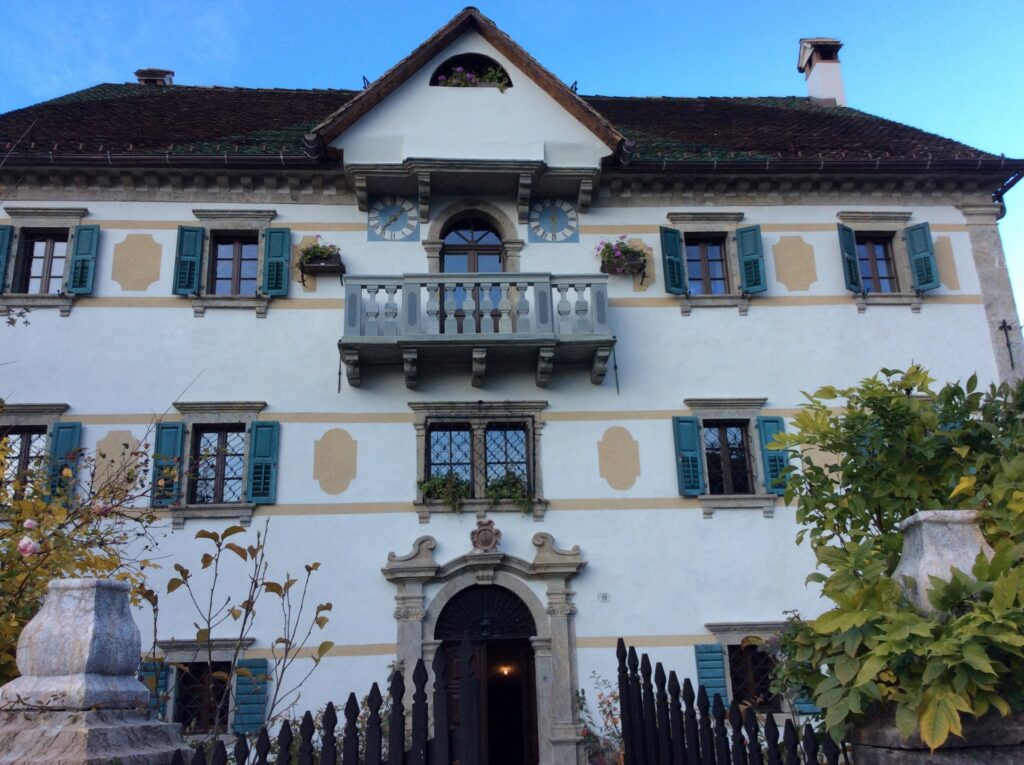
Palazzo De Gleria is an 18th-century historic house located in Carnia in Povolaro, a hamlet of the municipality of Comeglians; the only example of a Venetian villa present in the Carnic territory. The building was built by a family of merchants (cramars) and bankers who alternated their residence between Munich and Carnia so it presents an interesting mixture of Venetian and Bavarian architectural styles. The main façade is characterized by the entrance portal and the openings above in axis. The wooden doorway, with iron fanlight, is surrounded by a round-arched stone cornice. On the apex of the keystone , there is a shield in which the initials of the first owner B(iasio) D(e) G(leria) , the date of construction of the building “1768” and the cramars symbol are carved. On either side of the French window under the gable are 2 clock faces, one of which is painted, hence also the name of “House of Clocks.”
The interior is compartmentalized according to the traditional scheme of Venetian villas with a passing hall and side rooms. On the ground floor there is a vast room with vaulted ceiling formerly used as a fondaco. A typical 18th-century Carnic kitchen with central hearth and furnishings is preserved. On the second floor there are some rooms with Venetian terrazzo flooring. The building is surrounded by an entrance courtyard with 18th-century cobblestones and an Italianate garden with original stone furnishings. Other buildings from the same period can be seen in the small hamlet.
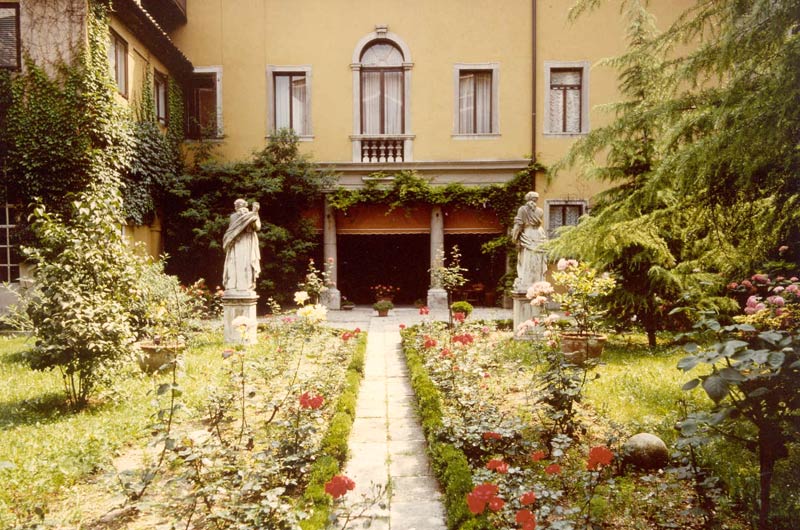
The palace, located in the city center in the immediate vicinity of the most suggestive places in Udine, is a construction of sober elegance that combines the characteristics of noble palaces and at the same time those of the manor houses of the Friuli province.
Once the door is opened, you find yourself in a portico of unusual size, a truly suggestive “small square” with unplastered walls (which leave the cobblestones or large construction stones exposed) and a beamed ceiling. On the right wall hangs a fresco, attributed to Gaspare Negro, detached from a house in Mercatonuovo in the 1930s and brought here. It is a valuable composition, executed according to the style of the people of Udine influenced by Pordenone and datable to around 1540.
Further on, a stone granary mask seems to remind us of the expanses of fields that once surrounded the palace (the “vast estate” mentioned by Rota in 1847), the landed properties of the owners of the house and the agricultural life that took place in the little houses – still owned by Orgnani – of which there remains a memory in a drawing from 1824.
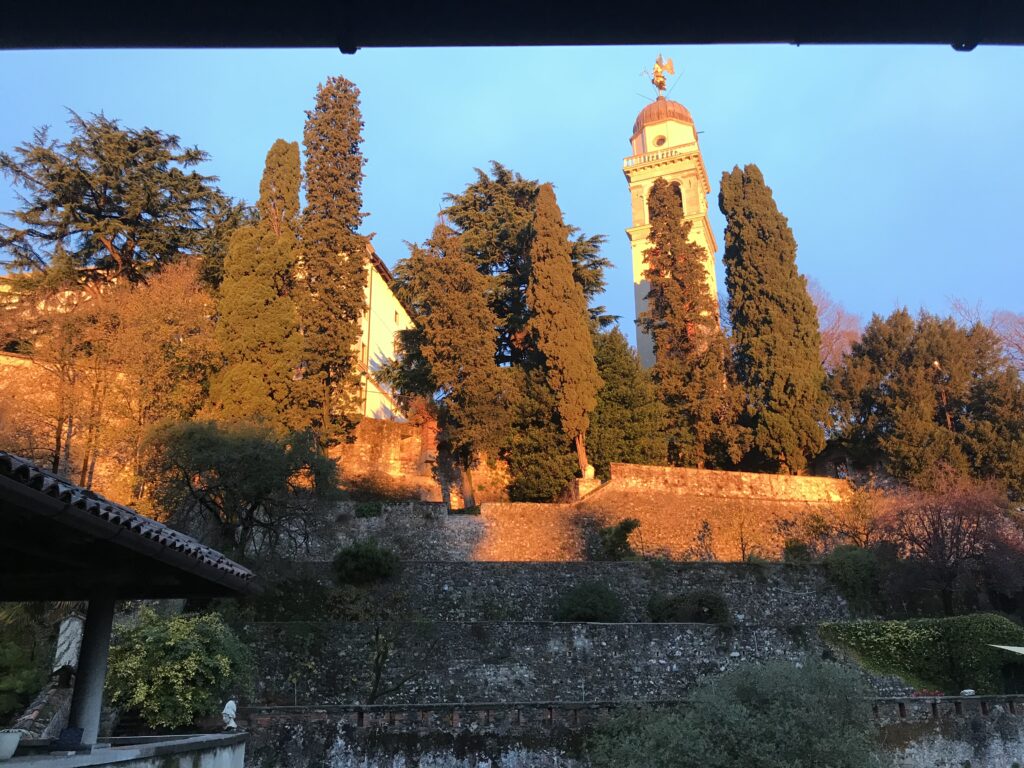
Palazzo Asquini stands in the historic center of the city of Udine at the foot of the castle on Via Manin. The palace complex consists of two main bodies connected by two secondary bodies; to the west a gallery with rooms to the east monumental staircase; between the two bodies a small courtyard and posteriorly a rectangular garden.
The Palace has been owned by the Asquini family since 1772, when Count Fabio Asquini, a distinguished agronomist, purchased it from the Pavona family.
The current appearance of the facade of the Palace, designed by architect Giuseppe Zandigiacomo, dates from 1857. The facade was completely restored in the second part of 2021, both in the stone cornices and by restoring it to its original yellow 700 color. On the main floor is a private oratory with an altarpiece depicting the Most Holy Conception by Venetian painter Pier Antonio Novelli dated 1794.
The facade of the second body of the palace is the one facing the castle. A sixteenth-century stone staircase between two rusticated pillars connects the lowest part of the garden with the first terracing, which is followed by five more terraces connected by a long stone staircase up to the cypress terrace at the top of the Castle hill. This last tier of the garden still shows the only remaining survivor of the 7 Austrian bombardment defense works built after the uprisings of 1848.
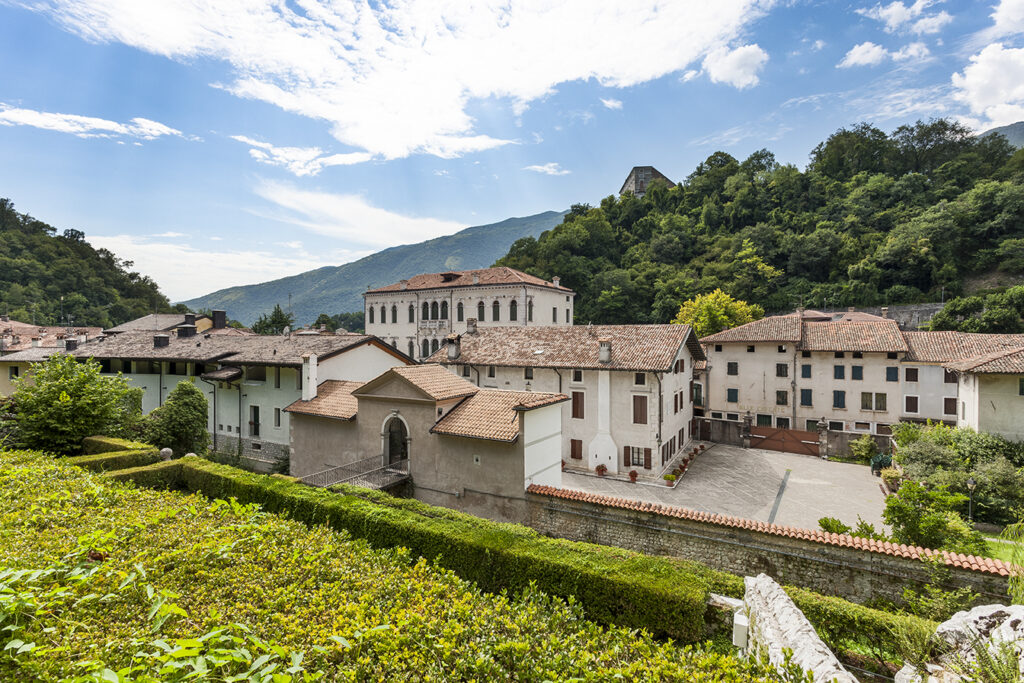
Palazzo Scolari is an aristocratic mansion dating back to the 17th century, declared by the Italian State to be a property of historical and cultural interest.
The pedestrian entrance from Gorgazzo Street features a small portico supported by two original stone columns that can be traced back to the 15th century.
Palazzo Salice-Scolari has a distinctive and original Italian garden created, in his time, by owner engineer Pietro Quaglia (1810 – 1882) after the death of his beloved wife Maria Mainardi in 1861.
The garden is set against the hill behind Palazzo Salice-Scolari and is accessed by a bridge across a stream. It consists of two distinct parts: the particular one with two-level terraces of embankments, which offer an original aesthetic view, and the external part characterized by a path, accompanied by a low hedge, that leads to a vantage point where it is possible to admire Polcenigo in its architectural and landscape complexity.
The terraces of the Italianate garden of Palazzo Salice-Scolari were restored in 1985, and the final result respected the original structure as conceived and realized by engineer Pietro Quaglia.
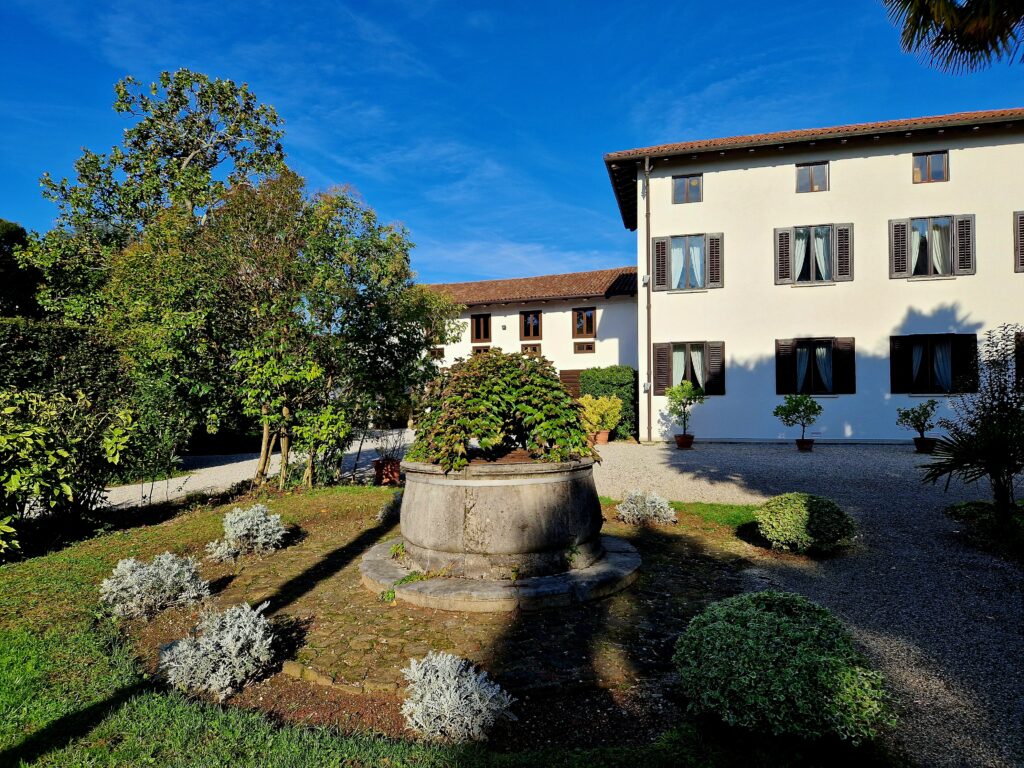
Villa Attems is a historic noble residence, still owned by the family of the same name, whose structure, with its agricultural appurtenances, form a small village that opens into a Historic park of five hectares. The generously extended park has been mentioned as one of the most beautiful in Italy and remains enclosed by original walls from the late 1700s. Villa Attems includes a production
of fragrances linked to the territory under the brand of “Acqua del Collio”.
Villa Attems è una Dimora Storica gentilizia, tuttora di proprietà dell’omonima famiglia, la cui struttura, con le sue pertinenze agricole formano un piccolo borgo che si apre su un parco storico terrazzato di cinque ettari.
La storia di Villa Attems trova le prime documentazioni alla fine del Cinquecento e di generazione in generazione, la tenuta passa per linea diretta all’interno della stessa famiglia, di padre in figlio, per 375 anni sino ad arrivare ai giorni nostri.
Il parco dall’estensione generosa è stato menzionato come uno tra i più belli d’ltalia e rimane chiuso da mura di cinta originali di fine “700.
Al suo interno vi trova naturale collocazione la fontana disegnata dall’illustre architetto di Maria Teresa d’Austria, Nicolò Pacassi su commissione della famiglia; un pozzo e un bunker risalente alla prima guerra mondiale, edificato nel 1917 dalla II Armata Zappatori, di cui il corpo ufficiali occupò la villa per numerosi mesi essendo il paese di Lucinico ultimo baluardo friulano, strategicamente perfetto per la presa di Gorizia durante la Grande Guerra.
La barchessa e le antiche scuderie, quali pertinenze agricole di Villa Attems, sono state oggetto di completo restauro e nel 1965 la villa padronale è stata oggetto di una prima importante ristrutturazione su intervento del noto architetto Aldo Cervi stretto collaboratore di Umberto Nordio
Villa Attems annovera una produzione di fragranze legate al territorio sotto il brand di “Acqua del Collio” con speciali profumazioni per ambiente e unici eau de parfum sia per uomo che per donna.
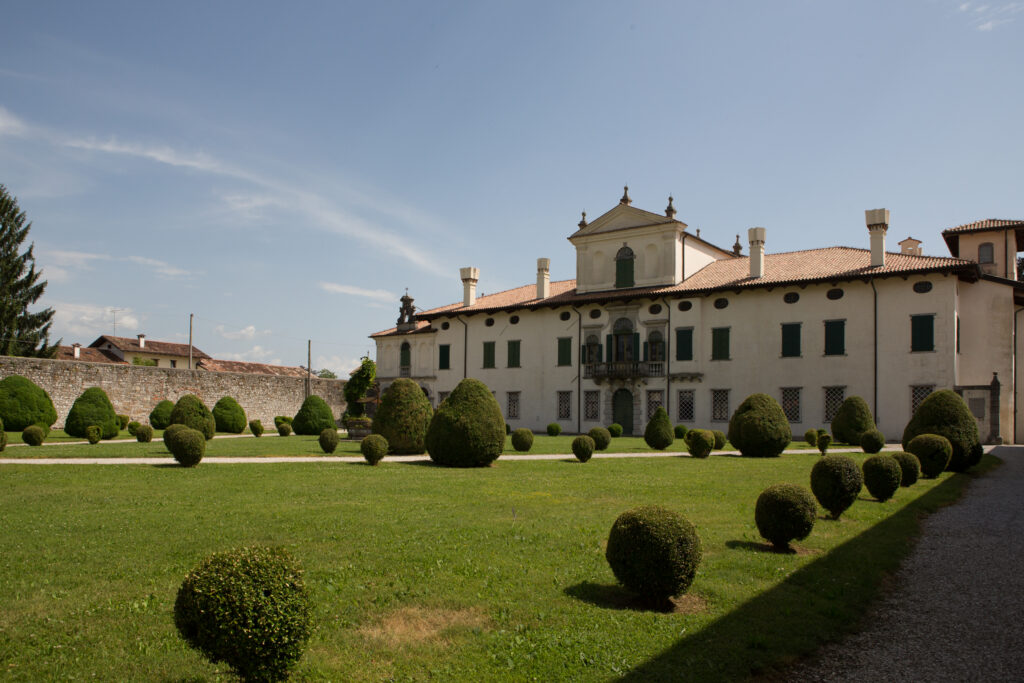
Villa de Claricini Dornpacher is located in Bottenicco di Moimacco, a small rural village on the outskirts of Cividale del Friuli.
It was built around the middle of the 17th century by the de Claricini Dornpacher family and since 1971 has been the seat of the foundation of the same name established at the behest of Countess Giuditta de Claricini, the last owner of the villa, with the aim of preserving its ancestral heritage and promoting studies and cultural events. The complex includes the large manor house, church and adjoining outbuildings.
The villa, while characterized by the distinctive features of the Venetian villa, maintains the horizontal development characteristic of the Friulian farmhouse. The interiors preserve the original furniture, a rich library with over 5,000 volumes, paintings and prints, and the countess’s collection of antique textiles and embroideries.
The villa opens onto a magnificent Italian garden and park with clusters of centuries-old beech, cedar, fir and holm oak trees. Framing and surrounding the villa is the estate vineyard from which de Claricini wine is produced, which is kept in the cellar next to the villa.
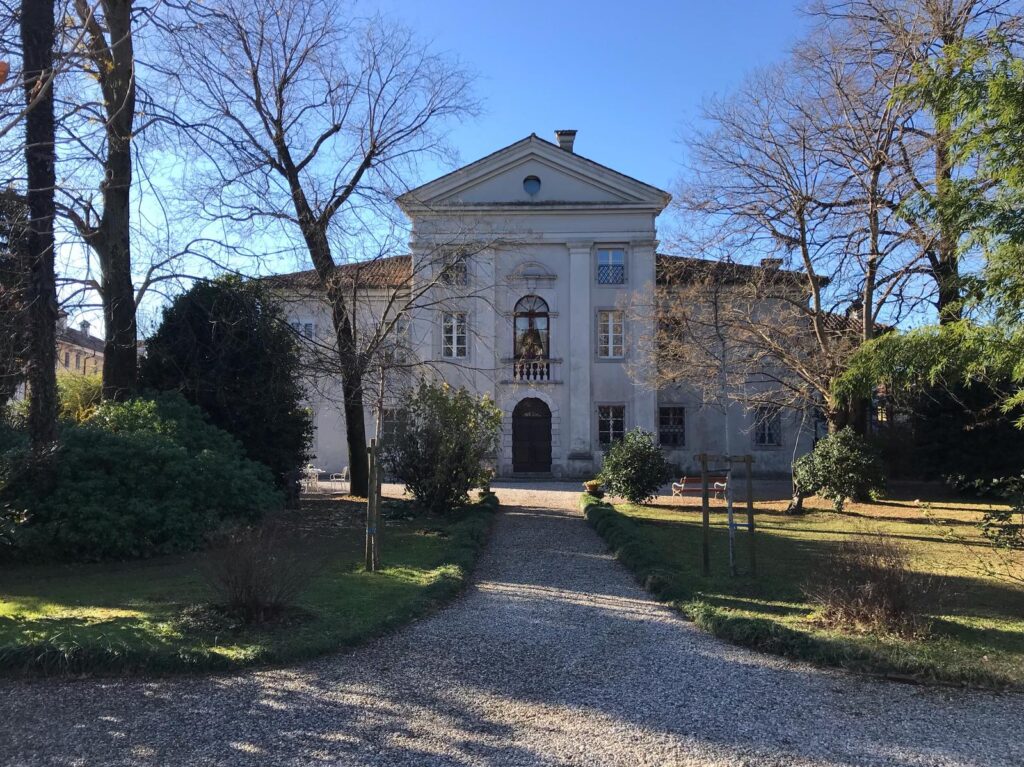
Villa del Torre is a private eighteenth-century villa, located in the heart of the Isonzo plain and its structure is inspired by that of the Venetian villas.
The villa stands in the center of Romans d’Isonzo in the eastern area of the historic center of the town exactly along the main road. It was built by the Lottieri barons of Gradisca d’Isonzo at the beginning of the eighteenth century, but their stay in Romans was so short that in the early 1800s a branch of the del Torre, a noble Friulian family from Cividale, purchased a part of it to establish their own activities there, including agriculture.
During the twentieth century Giuseppe del Torre also became the owner of the central body of the villa, saving it from the state of abandonment, in which it was due to the First World War and the neglect of the previous owners. It was Mario del Torre, Giuseppe’s son, who began a faithful restoration of the property, maintaining and restoring the original layout of the complex protected by the Superintendence of Archaeology, Fine Arts and Landscape of Friuli-Venezia Giulia.
From an architectural point of view, the villa shows an evident neoclassical imprint with numerous reminiscences of the Venetian typology and some typical references to Central European influence. The property is surrounded by a park of six thousand square meters, surrounded by a recently restored stone wall, within which there are plants dating back to the 18th century.
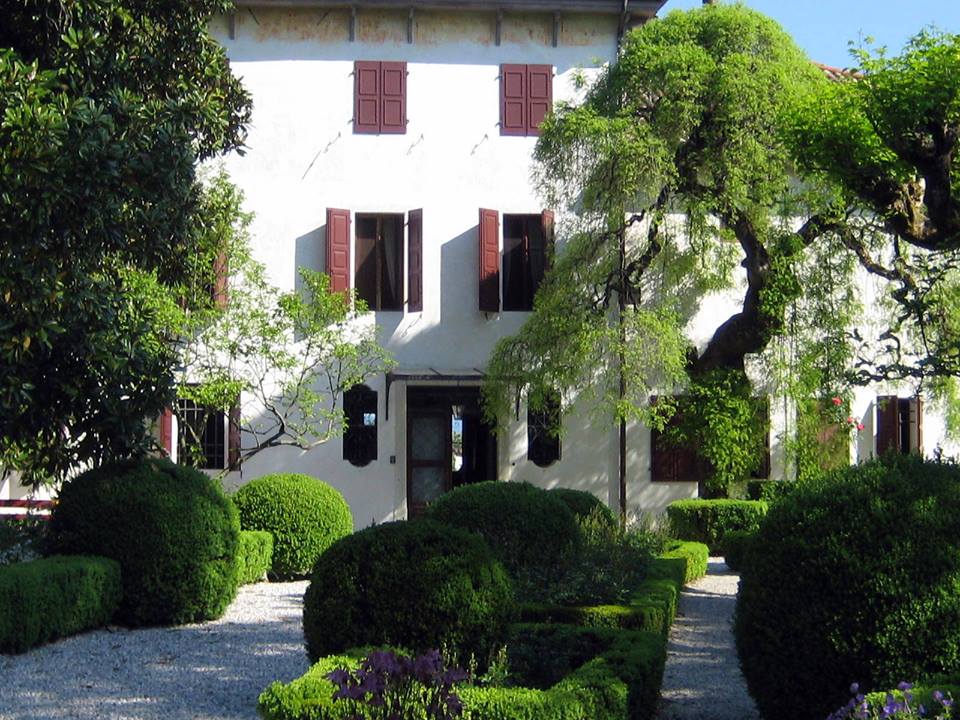
The layout of the house, originally rural, would appear to be seventeenth-century, based on analysis of the vaulting above the stone stairs, which lead from the ground to the second floor. The building was completely remodeled during the 19th century, to adapt it to the needs of the various owners who succeeded one another over time, through the construction of outbuildings and agricultural annexes (barn, stable, hayloft). Around 1850 the property was still in the name of the Della Donna family, owners of numerous properties and lands in Valvasone and neighboring towns.
The present Italianate garden dates from 1936 and consists of flowerbeds bordered by boxwood hedges dating from that time. The entrance to the villa is emphasized by the presence of a short driveway characterized by the presence of 4 linden trees, planted in the early 1900s. In the garden are valuable old trees, such as an osmathus fragrans, a sophora japonica pendula and a magnolia grandiflora. At the back of the villa is a centuries-old mulberry tree, the vegetable garden in cassoni, cultivated using the synergistic method, and a recent orchard area, planted with old varieties.
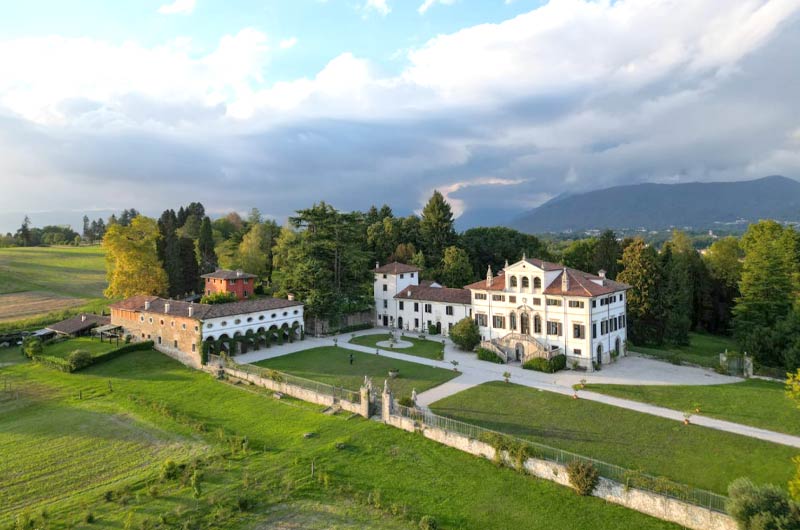
Villa Gallici Deciani is a magnificent 17th century Venetian residence located in Friuli, a region in the North East of Italy, where the Alps kiss the sea. A perfect setting for exclusive events and social gatherings.
Nestled in the splendid hilly landscape, among vines, olive trees, pastures and woods, with the enchanting backdrop of the Alps. The site is rich in history and the Villa and the park, reminiscent of the atmosphere of Downton Abbey, offer guests an authentic glimpse of the Friulian environment and its people. I am sure that your stay will give you unforgettable experiences and will allow you to savor the local delicacies, starting with the honey produced by bees on our lands!”
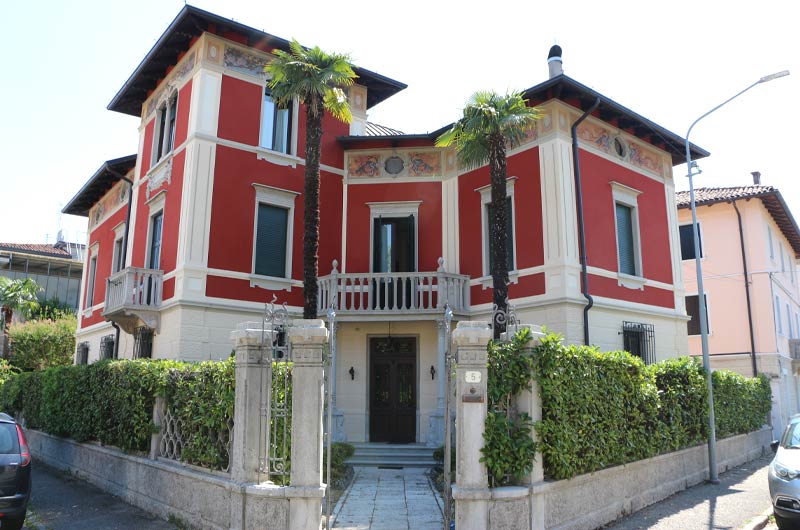
The recently renovated façade features hand-crafted decorations on the cornice, representing festoons of roses. The interior is similarly decorated with floral motifs.
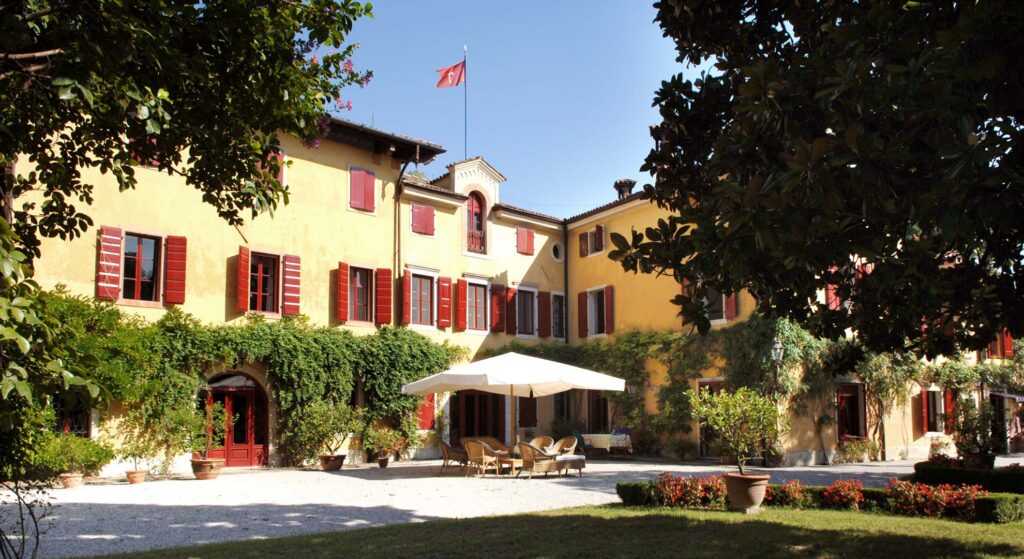
Villa Iachia is a historic house founded in the 18th century, located in the municipality of Ruda (UD), just a few kilometers from the Roman city of Aquileia and Gorizia. Between 1870 and 1880, Giacomo Davide Iachia established a farming enterprise that became one of the most important in the area. Today, Villa Iachia has been transformed into a tourist accommodation facility. The Iachia family, owners of the villa for more than two hundred years, belonged to the upper bourgeoisie of the city of Trieste. Giacomo Iachia married Jole Vivante, the youngest daughter of Giuseppe Vivante and Natalia Schmitz, sister of the renowned writer Italo Svevo. Spanning fourteen hectares, the park of Villa Iachia is the largest private park in Friuli Venezia Giulia, where two well-preserved trenches from World War I can still be seen.
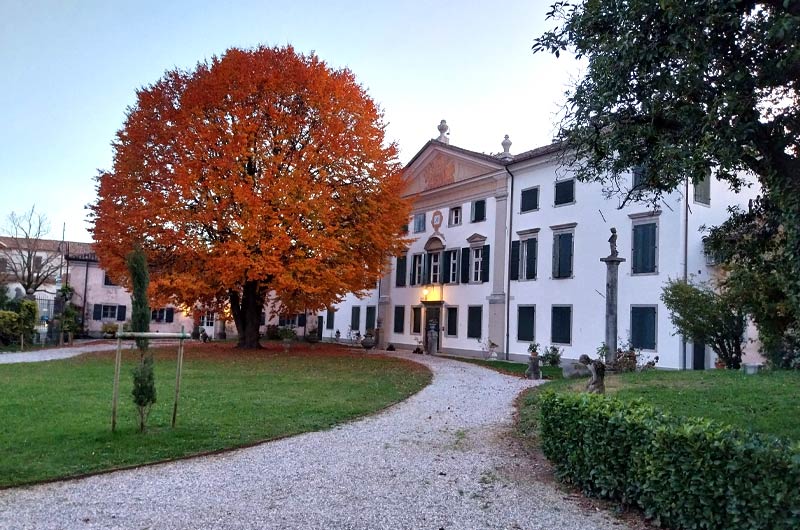
Built in the 17th century on behalf of the Lovaria family who still live there, it represents an example of the fusion of the styles of the Friulian manor house and the Venetian villa with an elongated façade and a central tympanum supported by pilasters.
The interiors are characterized by a neoclassical decorative apparatus from the early 19th century. Behind the villa there is a large park and Italian garden.
It has recently been the subject of maintenance work that has brought to light the fresco of the noble coat of arms included in the façade tympanum.
The manorial complex consists of the main building which, with the lateral rustic annexes, forms an irregular “C” planimetric system that encloses the courtyard of honor with a centuries-old plane tree. In 1800 the villa passed to the Spanish branch of the family, who made changes both to the façade and to the interior to adapt the simple forms of the original building to the needs and taste of the new owners.
The residence is a typical architectural example in which the model of the Friulian manor house is fused with that of the Venetian patrician villa with a façade marked by strong linearism.
The main body is divided into three floors, the elongated plan is doubled in width and has a central hall through, while on the front right side is located the staircase. The central part of the main façade is delimited by two pilasters resting on pedestals and is characterized by a triangular pediment, slightly projecting, decorated at its vertices with stone elements.
The courtyard of honor is dominated by a majestic and centuries-old plane tree of about 300 years that is catalogued among the monumental trees of Italy. At the back there is a park, in which you can admire a bright lemon house and rest in the shade of the large shrubs.
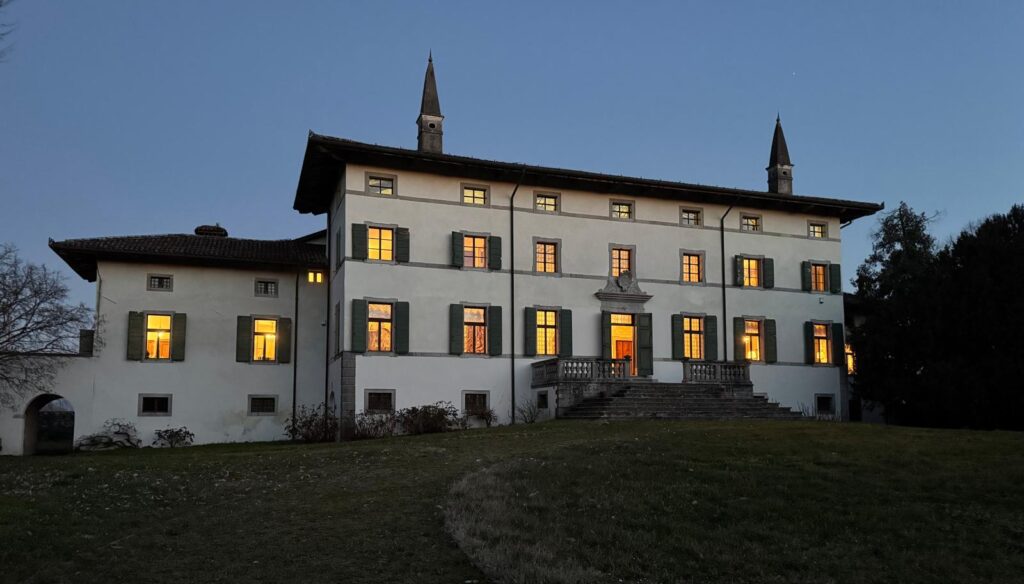
Built in the mid-17th century by the Mangilli, a family of merchants originally from Lombardy, it was renovated in the following century.
The villa is entered through the wrought-iron gate between two stone ashlar pillars topped by amphorae that decline at the sides in two volutes. Overlooking the garden, past the two semicircular fishponds, are the two barchesse and the villa, preceded by a balustraded staircase. The entrance portal bears above an elaborate architrave the Mangilli family crest, and the chimneys are embellished with cusped pinnacles.
Visible on the road is the chapel dedicated to the Nativity of Mary, erected in 1676 and renovated in the 19th century.
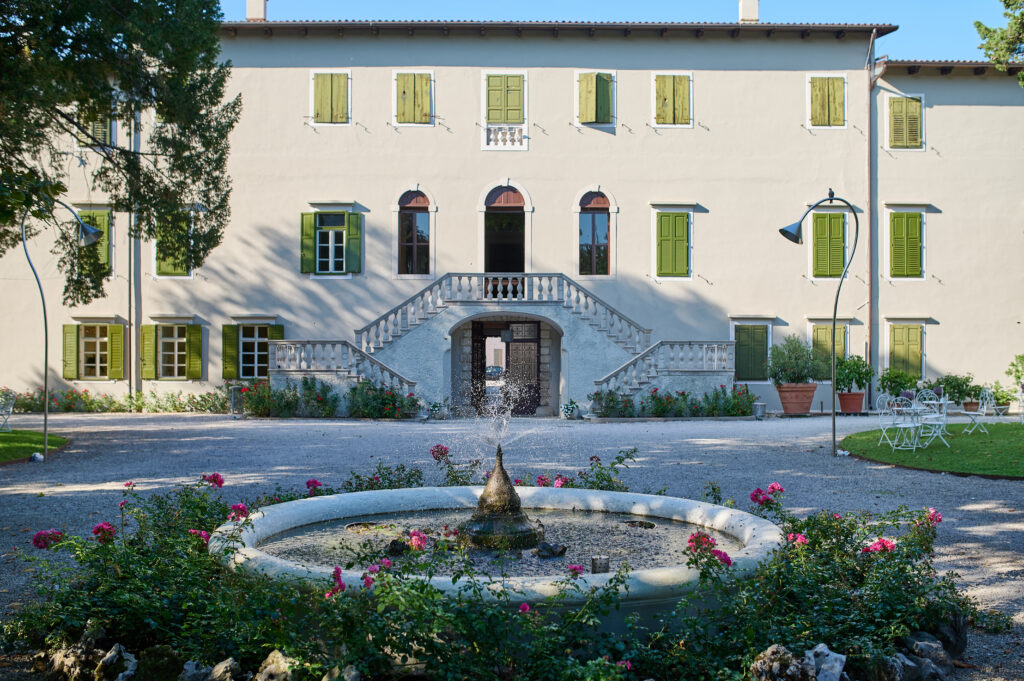
Villa Marchese de’ Fabris is the splendid mansion dating from the late 17th century, built at the behest of Marquis Ottavio de’ Fabris on the occasion of his marriage to Countess Savorgnan.
An enchanting, charming and cozy villa, surrounded by the green Gorizia countryside and its lush vineyards, offers a splendid glimpse for the visitor to abduct his gaze and take him to a rarefied dimension, rich in suggestion and elegance.
The Italian Garden envelops the visitor with its centuries-old trees, rose gardens and central fountain. In front is the central body embellished with a double stone staircase and around it the buildings of the property with the consecrated chapel dedicated to St. Anthony with a wooden altar of Hungarian workmanship to the side.
Below the staircase is a wide porch that houses a mosaic with the family coat of arms.
Climbing the outside stairs leads to the ballroom with light and dark gray Venetian seminato floor, the walls decorated in gradations of antique pink with precious white stucco and an antique portrait of the King of Poland.
At the outbreak of World War I, the villa came to be on the front line of the Isonzo; in October 1915 the building was almost completely destroyed, losing all interior furnishings, and in 1916 quickly rebuilt by the Italian Army, which made a military hospital.
After the defeat at Caporetto, in October 1917, and until the conclusion of the war, thus for an entire year, the villa was used by the Austro-Hungarian army always as a military hospital, as evidenced by an inscription on the wooden altar of the villa’s chapel, which recalls how the Imperial and Royal Reserve Hospital of Csáktornya (present-day Cakovec) was transferred from Hungary to Begliano, where it remained at the disposal of the wounded of the Piave.
Over time, its structure has undergone several mutations to its present one, with numerous rooms, a ballroom, a very large wine cellar, a valuable portico, the consecrated little church, a large front garden, and an Italian garden at the back, adjacent to a vineyard.
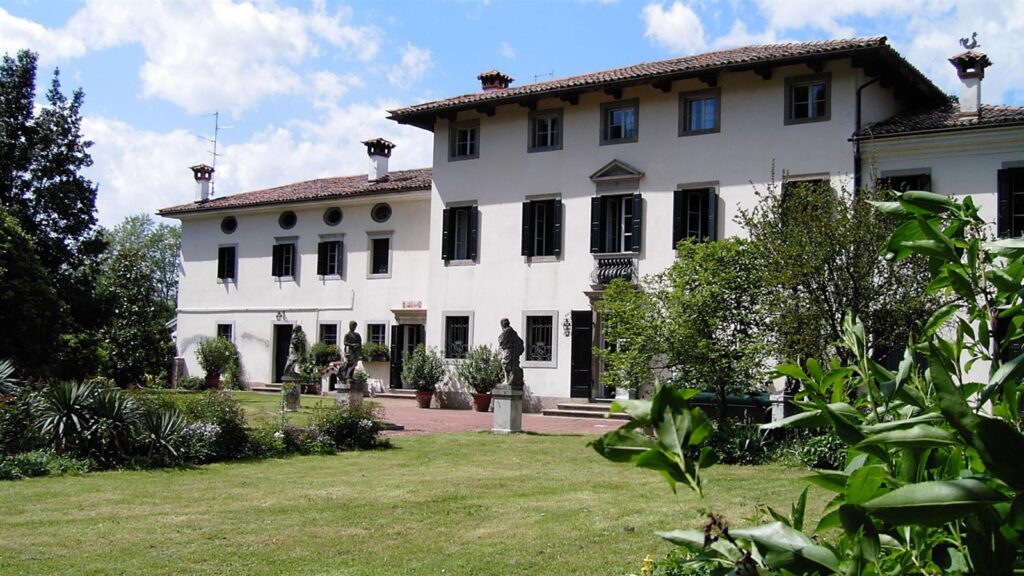
The first nucleus of Villa Orgnani Linda dates back to the 16th century, when the building complex was used as a hunting lodge, which Bernardino Orgnani purchased from Count Antonio Savorgnan in 1649. Between the 17th and 18th centuries, the building took on its current shape and size and since 1711 has been used solely as a residence.
In the Catalogo delle Ville Venete, the house is formally described as follows: “Walking along the long tree-lined avenue that separates the Villa from the town of Plaino, the charm of this country residence is perceived intact. The manor house has sober and elegant forms developed with the typical language of Venetian patrician architecture. The main façade is divided into three parts by the juxtaposition of the central volume, on three levels, with two lower lateral wings. The most significant decorative elements of the front are found in correspondence with the main halls: the high rectangular door on the ground floor and a French window with a wrought iron balcony and triangular tympanum on the main floor”.
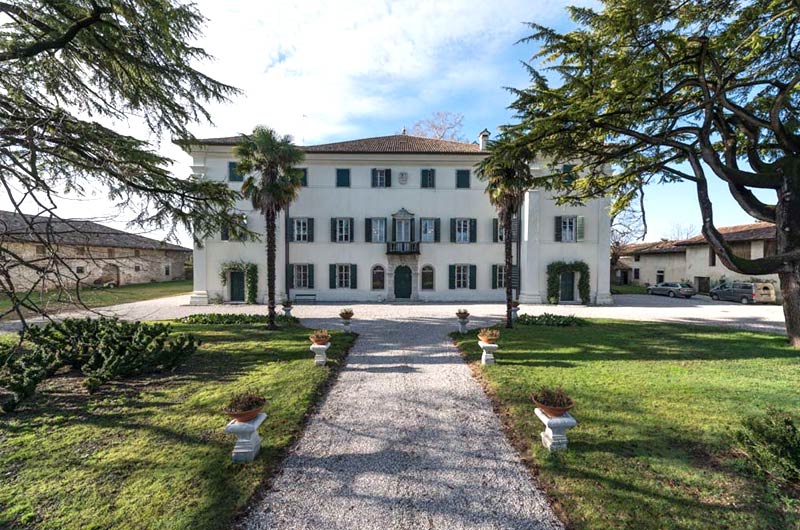
Villa Pace is located in the small rural village of Tapogliano, a few kilometers from Aquileia, a historic Roman city, from Palmanova, a star-shaped Venetian fortress city, and from Cividale, the medieval capital of Friuli, all three UNESCO sites.
Tapogliano is also a few kilometers from Grado, a historic beach of the Habsburg Empire.
The residence is located in the center of a large park, closed to the east and west by two barchesse used, one as a champagne barn for the Perusini winery and the other for hospitality with apartments for holiday homes.
Villa Pace is registered with Dimore Storiche Italiane and is one of the thousands of private residences in Italy that attract a number of visitors every year almost comparable to that of public museums and that together with them make our country precious and unique.
Cubic in shape, closed on the sides by corner towers that characterize many noble villas on the eastern border, it was built in the mid-seventeenth century by order of Carlo Maria Pace v. Friedensberg, Field Marshal of Emperor Leopold I and restored in the mid-eighteenth century by another Carlo Maria Pace. Villa Pace has always remained the property of the family that built it and retains much of the original furnishings, even though it was partially looted when the front passed during the First and Second World Wars. The restoration, to which the villa has been subjected over the last ten years, has allowed the recovery of the original spaces and extraordinary eighteenth-century mural paintings, which are the oldest known depictions in Italy of Captain James Cook’s voyages.
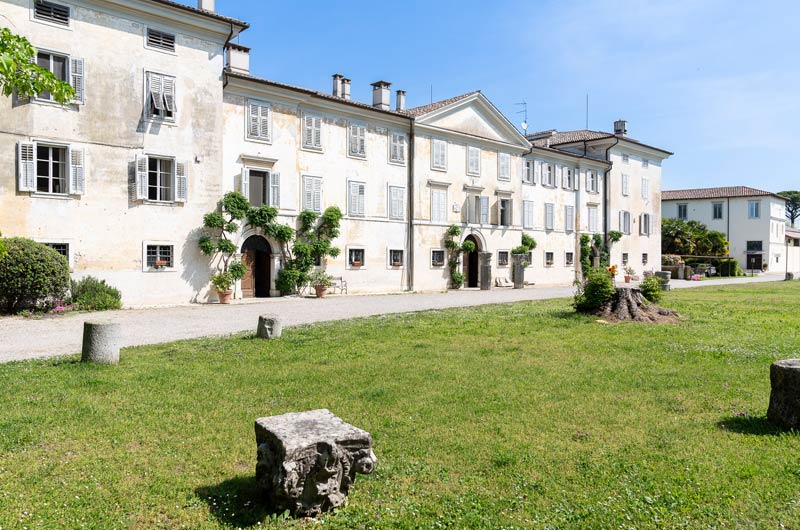
In the 11th century, the Benedictine Monastery of Santa Maria, from which the village took its name, had vast estates and increasingly assumed a prominent place in the history of the territory of Aquileia, influencing the religious, economic and social fortunes of all the surrounding areas.
In 1782, the ecclesiastical complex was sold to the Cassis Faraone family who transformed the Benedictine Monastery into a villa-farm.
In 1850, the estate was purchased by the family of Giulio Ettore Ritter de Záhony, originally from Frankfurt am Main. The Baron and Ritter de Záhony together with their son Eugenio, transformed the Monastero estate into an innovative agricultural company, dedicated to research and experimentation of new viticulture management techniques and the nursery production of rooted vines (one and a half million a year) exported throughout the Austro-Hungarian Empire.
Undoubtedly, the success of Baron Ritter de Záhony’s wine was also favored by the union of his daughter Elvine with Count Theodor de la Tour, a member of an ancient and noble French family of Catholic religion. In fact, in 1877, Elvine’s father gave the newlyweds as a dowry the substantial plot of land in Russiz, among gentle slopes in the heart of the Collio Goriziano.
The history of the ancient Ritter de Záhony family is imprinted in the history of the area for its excellent industrial activities. In Gorizia, where the Ritters worked cotton and silk, they built the Straccis workers’ colony. In Trieste, Giovanni Cristoforo Ritter de Zahony was among the founding members of Assicurazioni Generali and became its first President.
The Monastero residence in Aquileia opened to a series of illustrious guests who between 1863 and 1915 left their signature on the »Family Diary«. Among them, Archduke Charles Louis, hosted on the night of August 2, 1882 when he was in Aquileia to inaugurate the newly founded C. R. State Museum; Archduke Ranieri, governor of Lombardy-Veneto, guest of honor at an afternoon tea celebrated by local chronicles in 1890; and finally Frederick Augustus of Saxony, who arrived by car from Trieste in 1910.
The values transmitted by the Ritter de Zahony family have arrived unchanged over the centuries to Guido Federico Rossignoli who directly manages the family business with a credo that allows the continuity of a job, where the grapes are processed in cutting-edge cellars, in continuous dialogue with the territory.
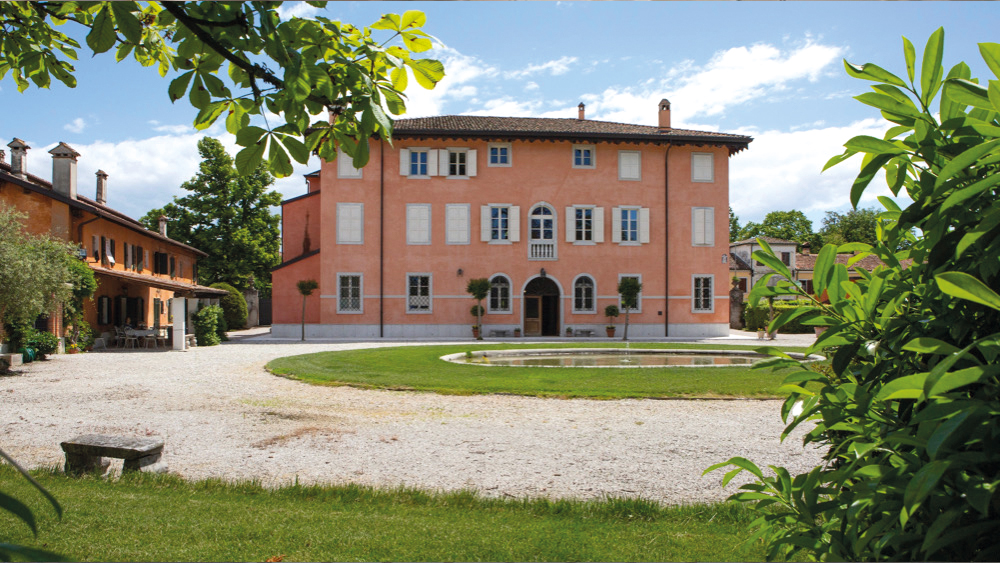
An 18th-century mansion nestled in a centuries-old park in the heart of Friuli Venezia Giulia. The date of construction of the villa is given as between the late 1600s and early 1700s.
In 1891, then Austrian territory, the property passed to Baron Franz Kuhn von Kuhnenfeld, minister of war and adviser to Emperor Franz Joseph.
In 1937 the property was acquired by Romano Vitas, who chose it as the site of the family winery.
Headquarters Email Address
To request information please fill out the form, we will get back to you as soon as possible.
DIMORE STORICHE AMICHE FVG
Via Quintino Sella n. 1/A, 33100 Udine
friuli@adsi.it
© 2024 DIMORE STORICHE AMICHE FVG
C.F. 94152620301
Privacy policy